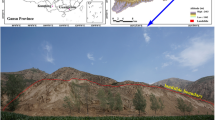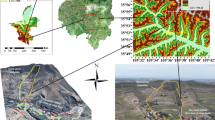Abstract
A large-scale long-runout landslide occurred at UTC + 8 03:50 local time on Aug. 21, 2020, in Hanyuan County of China. This landslide travelled approximately 550 m, causing 9 casualties and 8 houses destroyed. In this work, Discrete Element Method (DEM) is employed to explore the three-dimensional (3D) landslide mass movement. The simulation of landslide geometry evolution is performed using five groups of divisions so that the particle motion of different groups could be distinguished. The numerical post-sliding topography is in good agreement with the actual post-sliding topography. The simulation results show that the peak value of the average velocity during the mass movement is 6.295 m/s, and the main movement time is between 25 and 125 s. In addition, three primary aspects of mass movement are analyzed, including the landslide geometry, the sliding velocity, and the energy. The deformation of the front groups of landslide mass is the largest among all the groups, with a maximum moving distance of 550 m. The velocities of sliding mass decrease from top to bottom in depth and increase from rear edge to front edge. The energy analysis shows that only 1.05% of the gravitational potential energy has converted into the kinetic energy. Moreover, connectivity of the ruptured surface is adapted to simulate the rainfall effect on the mass movement. The result with the 60% connectivity is different with the results with the other connectivity. By comparison, when the connectivity reaches to near 60%, the locked segment fails and then the landslide occurs.






















Similar content being viewed by others
Data availability
Not applicable.
Code availability
Not applicable.
References
An HC, Ouyang CJ, Wang DP (2021a) A new two-phase flow model based on coupling of the depth-integrated continuum method and discrete element method. Comput Geosci 146:104640. https://doi.org/10.1016/j.cageo.2020.104640
An HC, Ouyang CJ, Zhou S (2021b) Dynamic process analysis of the Baige landslide by the combination of DEM and long-period seismic waves. Landslides 18:1625–1639. https://doi.org/10.1007/s10346-020-01595-0
Bertrand D, Trad A, Limam A, Silvani C (2012) Full-scale dynamic analysis of an innovative rockfall fence under impact using the discrete element method: from the local scale to the structure scale. Rock Mech Rock Eng 45:885–900. https://doi.org/10.1007/s00603-012-0222-5
Brideau MA, Shugar DH, Bevington AR, Willis MJ, Wong C (2019) Evolution of the 2014 Vulcan Creek landslide-dammed lake, Yukon, Canada, using field and remote survey techniques. Landslides 16:1823–1840. https://doi.org/10.1007/s10346-019-01199-3
Chen F, Gao YJ, Zhao SY, Deng JH, Li ZL, Ba RJ, Yu ZQ, Yang ZK, Wang S (2021) Kinematic process and mechanism of the two slope failures at Baige Village in the upper reaches of the Jinsha River, China. Bull Eng Geol Environ 80:3475–3493. https://doi.org/10.1007/s10064-021-02146-0
Fan XY, Tang JJ, Tian SJ, Jiang YJ (2020) Rainfall-induced rapid and long-runout catastrophic landslide on July 23, 2019 in Shuicheng, Guizhou, China. Landslides 17:2161–2171. https://doi.org/10.1007/s10346-020-01454-y
Feng ZY, Lo CM, Lin QF (2016) The characteristics of the seismic signals induced by landslides using a coupling of discrete element and finite difference methods. Landslides 14:661–674. https://doi.org/10.1007/s10346-016-0714-6
Fu WX, Liao Y (2010) Non-linear shear strength reduction technique in slope stability calculation. Comput Geotech 37:288–298. https://doi.org/10.1016/j.compgeo.2009.11.002
Ge YF, Tang HM, Ez Eldin MAM, Chen HZ, Zhong P, Zhang L, Fang K (2019) Deposit characteristics of the Jiweishan rapid long-runout landslide based on field investigation and numerical modeling. Bull Eng Geol Environ 78:4383–4396. https://doi.org/10.1007/s10064-018-1422-3
Gong SX, Zhao T, Zhao JD, Dai F, Zhou GGD (2021) Discrete element analysis of dry granular flow impact on slit dams. Landslides 18:1143–1152. https://doi.org/10.1007/s10346-020-01531-2
Guo J, Yi SJ, Yin YZ, Cui YF, Qin MY, Li TL, Wang CY (2020) The effect of topography on landslide kinematics: a case study of the Jichang town landslide in Guizhou, China. Landslides 17:959–973. https://doi.org/10.1007/s10346-019-01339-9
He K, Liu B, Hu XW (2021) Preliminary reports of a catastrophic landslide occurred on August 21, 2020, in Hanyuan County, Sichuan Province, China. Landslides 18:503–507. https://doi.org/10.1007/s10346-020-01566-5
Iverson RM, George DL (2014) A depth-averaged debris-flow model that includes the effects of evolving dilatancy. I. Physical basis. P Roy Soc A Math Phy 470:20130819. https://doi.org/10.1098/rspa.2013.0819
Katz O, Morgan JK, Aharonov E, Dugan B (2014) Controls on the size and geometry of landslides: insights from discrete element numerical simulations. Geomorphology 220:104–113. https://doi.org/10.1016/j.geomorph.2014.05.021
Krvavica N, Tuhtan M, Jelenić G (2018) Analytical implementation of Roe solver for two-layer shallow water equations with accurate treatment for loss of hyperbolicity. Adv Water Resour 122:187–205. https://doi.org/10.1016/j.advwatres.2018.10.017
Legros F (2002) The mobility of long-runout landslides. Eng Geol 63:301–331. https://doi.org/10.1016/s0013-7952(01)00090-4
Li WC, Li HJ, Dai FC, Lee LM (2012) Discrete element modeling of a rainfall-induced flowslide. Eng Geol 149–150:22–34. https://doi.org/10.1016/j.enggeo.2012.08.006
Liu W, He SM, Li XP (2016) A finite volume method for two-phase debris flow simulation that accounts for the pore-fluid pressure evolution. Environ Earth Sci 75:206. https://doi.org/10.1007/s12665-015-4920-7
Liu ZY, Su LJ, Zhang CL, Iqbal J, Hu BL, Dong ZB (2020) Investigation of the dynamic process of the Xinmo landslide using the discrete element method. Comput Geotech 123:103561. https://doi.org/10.1016/j.compgeo.2020.103561
Luo HY, Shen P, Zhang LM (2019) How does a cluster of buildings affect landslide mobility: a case study of the Shenzhen landslide. Landslides 16:2421–2431. https://doi.org/10.1007/s10346-019-01239-y
Ouyang CJ, Zhou KQ, Xu Q, Yin JH, Peng DL, Wang DP, Li WL (2016) Dynamic analysis and numerical modeling of the 2015 catastrophic landslide of the construction waste landfill at Guangming, Shenzhen, China. Landslides 14:705–718. https://doi.org/10.1007/s10346-016-0764-9
Qiao C, Ou GQ, Pan HL, Ouyang CJ, Jia Y (2018) Long runout mechanism of the Shenzhen 2015 landslide: insights from a two-phase flow viewpoint. J Mt Sci 15:2247–2265. https://doi.org/10.1007/s11629-017-4595-5
Shen WG, Zhao T, Crosta GB, Dai F (2017) Analysis of impact-induced rock fragmentation using a discrete element approach. Int J Rock Mech Min 98:33–38. https://doi.org/10.1016/j.ijrmms.2017.07.014
Shen WG, Zhao T, Zhao JD, Dai F, Zhou GGD (2018) Quantifying the impact of dry debris flow against a rigid barrier by DEM analyses. Eng Geol 241:86–96. https://doi.org/10.1016/j.enggeo.2018.05.011
Su ZN, Shao LT (2021) A three-dimensional slope stability analysis method based on finite element method stress analysis. Eng Geol 280:105910. https://doi.org/10.1016/j.enggeo.2020.105910
Su Y, Cui Y, Ng CWW, Choi CE, Kwan JSH (2019) Effects of particle size and cushioning thickness on the performance of rock-filled gabions used in protection against boulder impact. Can Geotech J 56:198–207. https://doi.org/10.1139/cgj-2017-0370
Utili S, Crosta GB (2011) Modeling the evolution of natural cliffs subject to weathering: 2. Discrete element approach. J Geophys Res Earth 116:F01017. https://doi.org/10.1029/2009jf001559
Wang FW, Sassa K, Wang GH (2002) Mechanism of a long-runout landslide triggered by the August 1998 heavy rainfall in Fukushima Prefecture, Japan. Eng Geol 63:169–185. https://doi.org/10.1016/S0013-7952(01)00080-1
Wang YS, Wu LZ, Gu J (2019) Process analysis of the Moxi earthquake-induced Lantianwan landslide in the Dadu River, China. Bull Eng Geol Environ 78:4731–4742. https://doi.org/10.1007/s10064-018-01438-2
Wei JB, Zhao Z, Xu C, Wen Q (2019) Numerical investigation of landslide kinetics for the recent Mabian landslide (Sichuan, China). Landslides 16:2287–2298. https://doi.org/10.1007/s10346-019-01237-0
Weng MC, Lin ML, Lo CM, Lin HH, Lin CH, Lu JH, Tsai SJ (2019) Evaluating failure mechanisms of dip slope using a multiscale investigation and discrete element modelling. Eng Geol 263:105303. https://doi.org/10.1016/j.enggeo.2019.105303
Ye F, Fu WX, Zhou HF, Liu Y, Ba RJ, Zheng S (2021) The “8·21” rainfall-induced Zhonghaicun landslide in Hanyuan County of China: surface features and genetic mechanisms. Landslides 18:3421–3434. https://doi.org/10.1007/s10346-021-01722-5
Yin YP, Xing AG, Wang GH, Feng Z, Li B, Jiang Y (2017) Experimental and numerical investigations of a catastrophic long-runout landslide in Zhenxiong, Yunnan, southwestern China. Landslides 14:649–659. https://doi.org/10.1007/s10346-016-0729-z
Zhao T, Houlsby GT, Utili S (2014) Investigation of granular batch sedimentation via DEM–CFD coupling. Granul Matter 16:921–932. https://doi.org/10.1007/s10035-014-0534-0
Zhao WH, Wang R, Liu XW, Ju NP, Xie ML (2020) Field survey of a catastrophic high-speed long-runout landslide in Jichang Town, Shuicheng County, Guizhou, China, on July 23, 2019. Landslides 17:1415–1427. https://doi.org/10.1007/s10346-020-01380-z
Zhao B, Zhao X, Zeng L, Wang SY, Du YC (2021) The mechanisms of complex morphological features of a prehistorical landslide on the eastern margin of the Qinghai-Tibetan Plateau. Bull Eng Geol Environ 80:3423–3437. https://doi.org/10.1007/s10064-021-02114-8
Funding
The authors wish to thank the National Key R&D Program of China (2022YFC308100), the National Nature Science Foundation of China (No. 42107172), the Key Research Project of Sichuan Province (No. 2021YFN0126), and the Fundamental Research Funds for the Sichuan University (No. 2021SCU12035) for the financial support.
Author information
Authors and Affiliations
Corresponding author
Ethics declarations
Conflict of interest
The authors declare no competing interests.
Rights and permissions
Springer Nature or its licensor (e.g. a society or other partner) holds exclusive rights to this article under a publishing agreement with the author(s) or other rightsholder(s); author self-archiving of the accepted manuscript version of this article is solely governed by the terms of such publishing agreement and applicable law.
About this article
Cite this article
Yuan, XY., Chen, ZF., Fu, WX. et al. Mass movement of a long-runout catastrophic landslide on Aug. 21, 2020, in Hanyuan County of China. Bull Eng Geol Environ 81, 501 (2022). https://doi.org/10.1007/s10064-022-03010-5
Received:
Accepted:
Published:
DOI: https://doi.org/10.1007/s10064-022-03010-5




